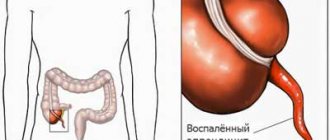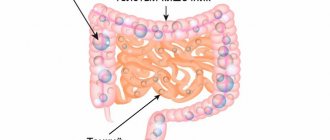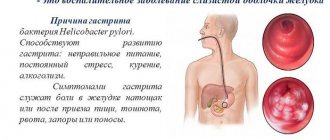Thanks to prompt diagnosis of acute appendicitis, it is possible to detect the disease in time and begin its treatment. This pathology is dangerous due to the appearance of serious complications, which is why it is so important to carry out surgical intervention as early as possible. To detect the disease in a timely manner, you need to know how to identify appendicitis at home.
Symptoms
To diagnose pathology at an early stage of development and distinguish it from other problems in the digestive system, you need to pay attention to the symptoms of appendicitis:
- Pain in the abdomen. With the development of appendicitis, pain is first felt in the navel area, after which it gradually moves to the right lower abdomen. Discomfort appears suddenly and is vague. Usually there is a dull aching pain that does not allow you to take a deep breath. In addition, they increase significantly when coughing or laughing.
- Forced body position. When appendicitis develops, a person cannot straighten up or move normally - this is due to abdominal pain. Another sign of inflammation is the forced posture of an adult or child - the patient lies on his side and raises his legs.
- Nausea and vomiting. With the development of appendicitis, abdominal pain is almost always accompanied by nausea. Debilitating vomiting that does not bring relief may also occur. Sometimes it happens once, but in most cases this condition lasts quite a long time. It is worth considering that in a child or teenager, vomiting is frequent, while in adults this symptom can occur literally 1-2 times. In old age there are no such symptoms.
- Increased body temperature. Usually this figure is 37.5-38 degrees, but in a child it can rise to 40 degrees. If the temperature increases significantly in an adult, this indicates the progression of inflammation.
- Abnormal stool. In most cases there is no this symptom. But if the appendix in an adult or child is located abnormally, constipation may occur. In rare cases, diarrhea may also develop. It is worth considering that in case of poisoning, loose stools bring temporary relief to a person, while in case of appendicitis the condition remains the same - abdominal pain does not disappear after defecation.
- Dry mouth. If abdominal pain is accompanied by this symptom, we can talk about the development of appendicitis.
Sometimes inflammation of the appendix causes frequent and painful urination. Symptoms such as pain in the genitals and lower back may also appear. The child may develop a runny nose and cough, which makes it difficult to diagnose appendicitis in a timely manner.
How to check for appendicitis at home
The main symptom of appendicitis is abdominal pain. However, it should also be noted that acute abdominal pain can also be observed with perforation of ulcers, ectopic pregnancies, ovarian apoplexy, renal colic, acute cholecystitis or pancreatitis, etc. Just like with appendicitis, these conditions require immediate transportation to a hospital, since in the absence of timely medical care, severe complications may develop, including death.
Localization of abdominal pain
In this regard, if symptoms of an acute abdomen appear (acute abdominal pain, vomiting, tension in the muscles of the abdominal wall), you must immediately call an ambulance. Attempts at self-treatment will only worsen the patient’s condition and lead to a waste of time. Also, before the ambulance arrives, it is forbidden to give the patient painkillers, as this blurs the clinical picture and significantly complicates further diagnosis.
Inflammation of the appendix should be differentiated from:
- acute gastroenteritis;
- acute pancreatitis and cholecystitis;
- perforated stomach ulcers;
- right-sided renal colic;
- pyelonephritis;
- ectopic pregnancies;
- ovarian apoplexy;
- acute adnexitis.
Read further: All about antibiotics for intestinal infections in adults and children
How to recognize appendicitis in adults at home
The symptom complex of acute abdomen includes a large number of pathologies that require treatment in a surgical hospital. It is impossible to carry out differential diagnosis at home. However, knowing the main symptoms of appendicitis, you can suspect it in the early stages.
How does appendicitis begin?
The first painful attacks extremely rarely appear directly in the right iliac region (RIL). Almost always, pain occurs first in the epigastrium, right or left hypochondrium. And then, within one to two hours, the pain moves to the PPO. This phenomenon is called Kocher's symptom.
Also in the first hours of the disease, there is a feeling of nausea and vomiting, fever up to 37.5, rarely up to thirty-eight degrees.
Despite the pain, the general condition was little affected. Patients are conscious, communicative, and able to adequately answer questions. There may be complaints of weakness, decreased or complete lack of appetite, and a feeling of nausea. The appearance of symptoms of severe intoxication, lethargy, and pronounced lethargy indicates the addition of peritonitis.
In the first hours after the onset of pain, vomiting appears. It is not abundant, does not bring relief and, as a rule, is one-time (children may vomit several times).
A characteristic sign of inflammation of the appendix is the appearance of the “toxic scissors” symptom - a discrepancy between the degree of fever and heart rate. Normally, an increase in temperature of 1 degree is accompanied by an increase in heart rate by about ten beats per minute. With inflammation of the appendix, normal or slightly elevated temperature is noted against the background of significant tachycardia.
Increased breathing is also noted. In children, more often than in adults, the right side of the abdomen lags noticeably when inhaling.
Painful sensations in the first hours of illness can be migratory in nature. The progression of inflammation is accompanied by a persistent displacement of pain in the PPO, as well as the appearance of stiffness of movements (when walking, the patient limps on the right leg) and a forced body position (lying on the right side with the legs pressed to the stomach).
How to recognize appendicitis in a child
Children may experience disturbances in general well-being to a greater extent than adults. Children are capricious, whiny, and react extremely negatively to palpation of the abdomen. In the first hours after the onset of pain, diarrhea may occur. Tachycardia increases faster.
Other manifestations of appendicitis are similar to those in adults.
Read further: Classification, types, causes, symptoms of appendicitis in adults and children
Methods for self-determination of appendicitis
How to recognize appendicitis? To check for yourself whether you have inflammation in the appendix, you can do the following:
- Lie down on a flat surface - bed or floor. Place your arms along your body, spread your legs slightly, and then bend your knees. In this case, the second person should lightly press the area in the lower right corner of the abdomen with the fingers of his right hand, and then sharply remove his hand. If pain occurs at this point, you should consult a doctor. With appendicitis, the groin, navel or left side often hurts.
- Lie on the floor, place your arms along your body, and straighten your legs. First, raise your right leg 50-60 degrees. At this moment, the second person should remove the edge of his hand quite strongly along the heel. Similar actions need to be done with the left leg. Pain in the right side of the abdomen is a characteristic symptom of appendicitis.
- To understand whether a child has a stomach ache, you should look for specific symptoms. If the baby suddenly squats down and cries a lot, this indicates the development of inflammation.
- To diagnose appendicitis yourself, you can try coughing. Echoes of pain will occur in the right corner of the abdomen.
- If appendicitis is suspected, the person should be asked to walk. When the appendix is inflamed, the stomach hurts while walking. If every step is accompanied by discomfort, we can talk about the development of appendicitis.
- It is worth carefully palpating the stomach. Tightness of the abdominal wall will help identify appendicitis.
The listed symptoms in an adult or child should be a signal to consult a doctor, since there is a risk of appendix rupture or chronic inflammatory process.
Painful symptoms of appendicitis: how to check them
How can you check the symptoms of appendicitis?
Painful symptoms are the most important and characteristic signs that indicate the development of acute appendicitis.
You can check them as follows:
- Voskresensky's symptom: when sliding your hand through thin clothing along the abdomen from the stomach to the lower abdomen, painful sensations occur in the right iliac region;
- Shchetkin-Blumberg symptom: with the fingers of one hand folded together, slowly and deeply press on the abdominal wall in the right iliac region, then the hand is sharply removed - after this a sharp pain occurs in the right abdomen;
- Rovsing's symptom: both hands are placed symmetrically in the right and left iliac region, after which the left hand pushes on the abdominal wall, resulting in sharp pain on the right;
- Obraztsov's symptom: when pressing with the hand on the abdominal wall in the right iliac region and parallel flexion of the patient's right leg straightened at the knee joint, a sharp pain occurs in the area where the appendix is located.
Watch useful videos on our YouTube channel:
What should you not do if you suspect appendicitis?
In such situations, it is strictly prohibited:
- Take laxatives or painkillers. Such actions will prevent the doctor from diagnosing inflammation of the appendix in a timely manner.
- Take medications for the intestines or stomach. They can cause an intense chemical reaction that can cause the appendix to rupture.
- Eat food before consulting a doctor. If the appendix is inflamed, emergency surgery may be required, and before surgery, you must refuse to eat. In addition, food can cause intestinal irritation, which will lead to increased pain.
- Apply a heating pad or warm compress to your stomach. Heat exposure will cause an acceleration of the inflammatory process.
If your stomach hurts and your temperature rises, under no circumstances should you hesitate. In such a situation, you should call an ambulance.
What not to do if you have appendicitis
If appendicitis is suspected, a number of restrictions come into force. Compliance with them allows you to avoid a sharp deterioration in health before receiving medical help. With such symptoms, the use of laxatives and painkillers is strictly prohibited. All this will create difficulties in diagnostics. The list of contraindications includes drugs for the stomach, as they can lead to rupture of the appendix.
Since the detection of this disorder is followed by surgery, you should refrain from eating before visiting a doctor. This will allow you to begin surgery faster. This restriction will also help avoid increased pain caused by increased load on the intestines. In case of appendicitis, thermal effects on the source of inflammation will become dangerous. Therefore, you should not apply a heating pad or anything warming to your stomach.
Diseases with similar symptoms
To determine inflammation of the appendix, additional examinations are often required. This is explained by the fact that the primary symptoms of the disease resemble signs of other pathologies. These include:
- pyelonephritis;
- Crohn's disease;
- inflammation of the uterus, tubes or ovaries;
- renal colic;
- peptic ulcer;
- colitis and enterocolitis;
- inflammation of the testicle;
- inflammation of small intestinal nodes;
- tear or stretch of the anterior abdominal muscles.
Diagnostics
To identify inflammation of the appendix, it is imperative to analyze the symptoms and conduct additional research:
- Urine and blood tests. When the appendix is inflamed, urine analysis remains normal, and this makes it possible to exclude kidney pathologies. Through a blood test, it will be possible to identify the inflammatory process, but the exact localization cannot be established.
- Ultrasound of the abdominal cavity. This is the fastest and most reliable method for diagnosing appendicitis.
- CT scan. This study is prescribed when there is doubt about the correctness of the diagnosis.
Now you know how to identify appendicitis at home in adults and children. This is very important for timely surgical intervention. Therefore, the very first symptoms of the disease should force a person to call an ambulance - the slightest delay can provoke dangerous complications.
People often confuse two concepts - appendicitis and appendix. Appendicitis is an inflammation of the appendix, a small appendage of the cecum, which is located in a person on the right under the liver, in the middle, between the right side and the umbilical cord.
How to distinguish appendicitis from other diseases with similar symptoms?
It is difficult to distinguish appendicitis from other pathologies of the abdominal organs on your own at home. Nausea, vomiting and abdominal pain accompany many diseases, so several additional tests must be performed to make a diagnosis:
- General analysis of blood and urine - a urine test is carried out in order to exclude kidney disease (in case of appendicitis, the indicators are normal). In a blood test, a sharp increase in the level of leukocytes is observed, which indicates the presence of inflammation in the body.
- Ultrasound examination of the abdominal organs is a quick and reliable way to diagnose appendicitis. Read more about ultrasound of the appendix →
- Computed tomography – if appendicitis is suspected, it is performed quite rarely. It is prescribed when there is doubt about the correctness of the diagnosis.
Modern research methods and knowledge of simple diagnostic rules help to avoid such serious complications as peritonitis, sepsis, internal bleeding and many others. Treatment of the disease is usually surgical.
Author: Yulia Khaimanova, doctor, especially for Moizhivot.ru
Where is the appendix located?
The appendix is an extension of the cecum
Its lower part descends to the pelvis. It can also be located behind the cecum. The organ is small in size: on average, 7-9 cm, its diameter is 0.5-1 cm. A small flap fold separates it from the cecum, preventing intestinal contents from entering the appendix.
Thanks to this, the appendix cavity remains clean. This organ also plays a role in digestion, being a kind of incubator for beneficial bacteria. Not all mammals have this organ.
For example, the cat family does not have this appendage. But rodents have it, for example, rabbits and guinea pigs. Human relatives according to the biological classification - monkeys - also have an appendix. Herbivores have a developed appendix.
How does appendicitis hurt?
Maximum pain during inflammation of the appendix occurs in the area where it is located, that is, slightly to the right of the umbilical cord. The pain of the appendix, raised closer to the liver, is not difficult to confuse with the pain of the liver itself. If the appendix is lowered to the pelvis, then its pain is masked as an ovarian pathology; in men, as an inflammation of the bladder. When the appendix is located posteriorly, the pain is localized in the lower back and felt in the groin.
Pain appears unexpectedly, without any particular reason. The inflammatory process can begin with mild or tolerable pain, followed by an increase, or it can immediately manifest itself with acute stabbing pain, which will be acute and unbearable as long as living nerve endings are sensitive. Therefore, when the appendix is inflamed, you cannot calm down if the pain subsides. On the contrary, the patient must be urgently hospitalized.
Appendicitis is also characterized by other symptoms: general malaise, nausea, and even single vomiting appear. Lost appetite. The temperature rises to 37.2-37.7o C and may be accompanied by chills. A light coating appears on the tongue. The heart rate increases to 90-100 beats per minute.
How to independently determine appendicitis
As a rule, pain with appendicitis is sharp and constant. They appear in the area of the right hypochondrium and can radiate to the stomach and intestines. Self-diagnosis must be carried out in a supine position, be sure to relax the abdominal muscles as much as possible. It is advisable to have an assistant carry out the inspection, but you can do it yourself.
Inflammation of the appendix can be distinguished as follows:
- You should lightly tap the knuckle of your index finger in the area of the right hypochondrium. With appendicitis, as a rule, pain appears there.
- The same should be done on the opposite side. There should be no pain on the left side. If there is a difference in sensations, we can talk about suspecting a disease.
- The cough reflex can also help in diagnosis. If you experience discomfort or noticeable discomfort in the right side area when coughing or sneezing, you should visit a specialist as soon as possible.
- Acute appendicitis can easily be defined as follows. To do this, you need to press on the abdominal area on the right, hold for a few seconds and release. If the appendix is inflamed, during this manipulation the pain subsides a little, but why does it appear again?
- The pain is much more noticeable if a person lies on his left side with his legs straight. Pain from appendicitis is reduced if you take the fetal position and lie on your right side. If this happens, you should call a doctor immediately.
How to determine appendicitis in a child:
- children are characterized by the addition of dysfunction of the gastrointestinal tract (nausea, vomiting, stool disorder);
- the baby becomes whiny, apathetic, lethargic;
- he may be bothered by pain when changing body position, while squatting, as well as when performing routine activities (dressing, showering, etc.);
- Children often experience an increase in temperature;
- If a child is under 2 years old, he is unlikely to develop appendicitis, which is explained by the structure of his intestines. But the behavior of older children must be carefully observed, since they can endure mild pain without informing their parents about it.
When an inflammatory process is diagnosed, you should immediately call a doctor, after which it is necessary to provide first aid to the victim. This will help alleviate the person’s general condition, reduce pain, and minimize the risks of complications and rupture of the appendix.
What can you do at home?
First aid for appendicitis begins with placing the victim in bed. It is recommended to move as little as possible so as not to accelerate inflammatory processes in the organ. You should put something cold on the abdominal area: a wet towel, a heating pad with cold water, or ice wrapped in a cloth. All this will help reduce discomfort until the ambulance arrives.
This is prohibited:
- eat food, drink plenty of fluids;
- take any medications, especially painkillers;
- laxatives are strictly prohibited;
- try to endure the painful sensations.
If there is a suspicion of appendicitis, it is better to play it safe than to later eliminate unnecessary problems that arose due to ignorance.
What symptoms characterize the disease?
To recognize this disease in yourself, you need to know how appendicitis manifests itself, in addition to the fact that it causes significant discomfort. Inflammation of the appendix is accompanied by characteristic symptoms that make themselves felt precisely at the initial stage of the disease.
Symptoms that should alert you:
- Diarrhea, constipation and other intestinal disorders; however, it is worth noting that diarrhea due to appendicitis is extremely rare;
- Periodic vomiting not associated with food intake;
- Symptoms of general intoxication of the body (weakness, lethargy, apathy, drowsiness);
- Possible increase in body temperature;
- Blood pressure surges;
- Cardiopalmus;
- Appearance of sticky sweat on the skin.
If, together with these signs, pain is diagnosed on palpation of the right iliac region, we can say with confidence that there is inflammation of the appendix.
Diseases that can be confused with appendicitis
Often, an attack of appendicitis can be confused with inflammation of organs nearby the appendix, which can give similar symptoms. The right side may hurt due to irradiation of pain, localized in a completely different place.
Diseases with similar symptoms:
- exacerbation of cholecystitis;
- intestinal obstruction or common colic;
- gynecological diseases and ectopic pregnancy;
- hernias;
- pyelonephritis;
- gastro-diseases;
- lower lobe pneumonia.
If there is another disease that is not associated with inflammation of the appendix, other signs appear that are almost impossible to distinguish on your own. To do this, it is necessary to be examined using abdominal ultrasound, x-rays and other diagnostic methods.
How to recognize the signs of appendicitis
Appendicitis is inflammation of the appendix
In addition to acute pain in the abdominal area, which may have other causes, appendicitis can be recognized by the following signs:
- Gently tap the pad just below the last right rib. With appendicitis, pain is always felt there; For comparison, do the same study on the left side; there should be no pain there.
- Let the patient try to cough. Increased pain in the right area will confirm that the patient has an inflamed appendix.
- In the area of acute pain, lightly press on your stomach and hold in this position for a few seconds. The pain should ease. If you have acute appendicitis, the pain will intensify as soon as you remove your hands.
- Advise the patient to take the fetal position, that is, lying on his right side with his legs tucked under him and curled up. In this position the pain will ease. If you change your position, for example, turning to the other side, stretching your legs, the pain will return again.
Important: under no circumstances should you palpate the abdomen yourself, that is, feel it and knead it. Otherwise, this can lead to rupture of the appendix and, accordingly, inflammation of the abdominal cavity - peritonitis.
Whatever the result of self-diagnosis, in any case, in case of acute pain in the abdominal cavity, no matter how it is localized, and no matter what disease it is disguised as, it is necessary to call an ambulance or a local doctor. Because pancreatitis, cholecystitis, gastric ulcer, or inflammation of the female organs and bladder are indications for immediate referral of the patient to the hospital.
Actions for exacerbation of appendicitis
If it was possible to confirm the diagnosis at home, then you must immediately call an ambulance. When appendicitis worsens, one cannot hope that self-medication can eliminate the disease. Otherwise, with an inflamed appendix and inaction, death can occur. We must not forget that the patient may have granulosa appendicitis, which is characterized by putrefactive inflammation. Therefore, there are actions that are strictly prohibited in case of inflamed appendicitis.
Main symptoms of appendicitis. Part 1
Main symptoms of appendicitis. Part 2
| Action | Short description |
| Taking painkillers | Diagnosis of appendicitis, in particular, occurs precisely by the localization of the pain syndrome. This is especially evident upon palpation. Therefore, it will be extremely difficult for a doctor to confirm the diagnosis without determining pain. In this case, only complaints will not be enough. Distortion of the clinical picture under the influence of analgesic drugs can lead to death |
| Applying compresses and various warming agents | Under the influence of heat, the inflammatory process will increase, which will only complicate the patient’s condition |
| Taking laxatives | When one of the symptoms of appendicitis is a problem with stool, then laxatives can only aggravate the clinical picture (may result in a rupture of the appendix) |
| Taking antacids | These medications will only increase the pain syndrome of an inflamed appendix. |
| Eat food and drink | It is not recommended to eat or drink before doctors arrive, as this may lead to aspiration during surgery. |
Carefully! Failure to comply with these rules can lead to complications of the condition, even death.
Signs of appendicitis in children
Symptoms of appendicitis are quite characteristic
If an adult can explain where, what and how it hurts, then with a child everything is much more complicated. And the younger the child, the more difficult it is to conduct an anamnesis. He cannot explain either the nature of the pain or its location. The child just hurts everything.
But, having heard that they are leaving him in the hospital and that something will be cut out, the baby may unexpectedly “get well.” Don't flatter yourself. The child does not understand that his deception may cost him his life. He wants to return to his usual life, and be closer to his mother, to his family, to everything that promises him warmth and security.
He may begin to be capricious and throw a tantrum demanding to be taken home. Explain to him that the subsided pain is the death of the nerve endings that should feel pain, and that if he does not listen to the doctor, he may die. Try to be with your child at these moments.
Diagnostics in hospital
The answer to the question of how to determine the presence of appendicitis for sure is to go to the hospital. The doctor will conduct a survey and examination of the victim, after which he will select the most appropriate tactics for further diagnosis and treatment. The necessary laboratory examinations begin with a general blood and urine test, which will show the general clinical picture of the disease. A blood test for appendicitis is full of leukocytes, which directly indicates possible inflammation of the appendix.
If diarrhea occurs due to appendicitis, a stool test is also prescribed to rule out intestinal diseases. Diagnostic studies using ultrasound, X-ray radiation are also prescribed; in severe cases, laparoscopy may be prescribed.
Methods for diagnosing appendicitis
Modern methods for diagnosing appendicitis make it possible to eliminate errors when making a diagnosis. For this purpose, laboratory and instrumental studies are used.
Laboratory research
From laboratory tests the following are carried out:
- Analysis of urine. When the appendix is located posteriorly, the inflammatory process can affect the walls of the ureter, right kidney, and bladder. And then blood cells - red blood cells and white blood cells - will be present in the urine in increased quantities.
- Blood analysis. The development of the inflammatory process is reflected in the composition of the blood - an increase in leukocytes and immature neutrophils is detected. But the white blood cell count increases only in 90 percent of cases, and even decreases in HIV-infected patients.
Thus, laboratory studies of biological fluids do not provide a clear picture of the process.
Instrumental studies
Diagnosis of appendicitis includes the following studies:
- X-ray showing the abdominal and chest organs;
- Ultrasound;
- Laparoscopy;
X-ray examination reveals the following signs:
- The contour of the cecum is modified, and an accumulation of fluid is visible in the cavity of its dome;
- Pneumatosis (bloating) of the walls of the ileum and colon is observed;
- Concentration of leukocytes on the gastrointestinal mucosa;
- Ultrasound shows changes occurring in the inflamed appendix in most patients.
Ultrasonography
Pain in the right side as a symptom of appendicitis
In most patients, ultrasound reveals an inflamed appendix. Usually, with inflammation, the appendix looks changed, and signs of inflammation are observed:
- The inflamed process almost doubles in diameter
- The walls thicken 2-3 times;
- The shape of the process can take the letter S
- Stones may be found in the appendix cavity;
- Merging of the walls is observed.
Laparoscopy
Surgical diagnosis laparoscopy shows the following signs of appendicitis:
- Changes in the shape of the appendix;
- Increased wall density;
- Blood flow to the abdominal cavity;
- Accumulation of leukocytes on the mesentery;
Laparoscopy makes it possible to distinguish between gangrenous and phlegmonous forms of appendicitis. In the gangrenous form, the nerve cells die and the walls of the process are destroyed. In this case, necrotic tissues acquire a black-green color. With phlegmonous - a critical enlargement of the appendix, a condition when it can burst. These signs indicate the need for urgent surgical intervention.
How to treat appendicitis?
If a doctor diagnoses acute appendicitis, there can be only one treatment method - surgery for the purpose of ectomy, that is, removal. Unfortunately, medicine has not invented other ways to cure appendicitis, although it has recognized the importance of the appendix in the body as part of the immune system.
After surgery, it is important to avoid complications. It is necessary to protect the sutured incision from suppuration. If the outcome of the operation is good, the patient will have the stitches removed within a week and sent home. In elderly people, patients with diabetes, and heart patients, healing is much slower, and with a good outcome, the postoperative period lasts 10 days. It is not recommended to take a bath for a month, much less go to the sauna. Such loads on a fragile scar slow down the healing process, making it rough and ugly.
Барышни с wowvolgodonsk.ru встречаются парнями за деньги, реальные индивидуалки в Волгодонске, если нужен головокружительный досуг. Если вы заказываете проститутку для себя и друга, то девочки не откажутся обслужить вас двоих одновременно. Очаровательные реальные индивидуалки в Волгодонске, восхитительные и горячие, они такие интересные и раскрепощённые, что все твои потребности будут удовлетворены. Выбери девушку сейчас.











